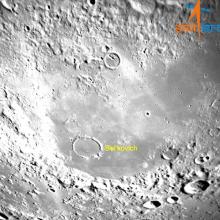Listen to today's episode of StarDate on the web the same day it airs in high-quality streaming audio without any extra ads or announcements. Choose a $8 one-month pass, or listen every day for a year for just $30.
You are here
Moon and Saturn
The Moon and Titan, the largest moon of Saturn, have something in common: The best places to get wet are at the poles. The Moon has lots of water ice. And Titan has actual liquid — lakes and seas filled not with water, but with hydrocarbons.
On the Moon, the ice is mixed with dirt at the bottoms of deep craters. Sunlight never hits the crater floors, so the ice remains frozen. A recent study suggested there’s more than a billion tons of ice around the poles, with most of it near the south pole.
Because of that, most lunar exploration over the coming years will be targeted at the south pole. Robotic landers will sniff out and study the ice. And human explorers may use the ice for water, oxygen, and rocket fuel.
On Titan, most of the wet stuff is near the north pole — about 95 percent. The largest body of liquid, the Kraken Sea, holds more than all the Great Lakes combined.
Differences in climate and landscape account for some of the imbalance between the poles. But one study says the major difference is that the southern landscape is more porous. The liquid ethane and methane can drain away to lower latitudes, where they evaporate — leaving the south pole much drier than the north.
And Saturn appears close to our Moon the next couple of nights. Tonight, it’s to the left of the Moon as they climb into good view by 10 o’clock, and above the Moon at first light. The giant planet looks like a bright star.





